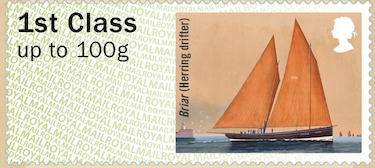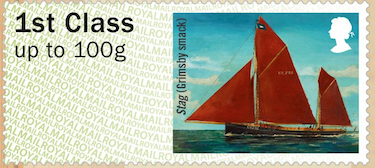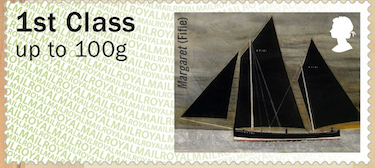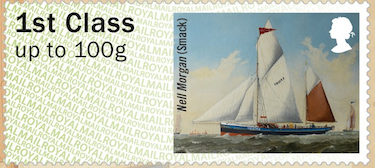Norvic Philatelics - GB New Stamps and Special Postmarks
Pictorial Faststamps: Working Sail - 18 February 2015
Pictorial Post & Go stamps appear in
machines in UK Post Offices for defined periods of time in the year and
this series is intended to provide attractive stamps that are appropriate
for the season in which they are issued.
In 2015 the subject matter and pictorial designs for Post & Go will vary
as wildlife and natural history subjects are replaced. Two of the sets
are linked as they will feature boats and ships. Heraldic Beasts will
be issued for the FIP exhibition in May. Following a request from Post
Office Ltd in 2013 for a Christmas set, a final set of four new designs of
Post & Go will be issued for Christmas on winter animals.
In this first set Working Sail features fishing and cargo boats of types
relevant to regions of the UK. All paintings date from around the turn
of the 19th / 20th Century.
Post & Go terminals allow customers to weigh their letters and packets,
pay for and print postage stamps and stationery supplies, often without the
need to visit the counter. The first Post & Go machine was trialled in
The Galleries Post Office® in Bristol in 2008. The labels will be used
in Post & Go machines at Post Offices around the country, and from new
Royal Mail machines at Spring Stampex. The labels can be obtained with
6 different service indicators: 1st class up to 100g & 1st class Large
up to 100g, a dual-value Europe up to 20g/World up to 10g, Europe 60g,
Worldwide 20g, and Worldwide 60g. The stamps are dispensed singly or
in strips of up to 5 or 6 (depending on the machine) of the same value or
various values.
From top left: Falcon, Briar, Harry, Stag, Margaret and Nell
Morgan
|
|
Over the centuries, the beauty of sailing ships inspired innumerable grand
paintings, including enormous seascapes and complex battle scenes – but it
is the work of folk artists who painted on a more humble scale, observing
ships as they came into the port, that has captured for posterity many types
of traditional merchant and fishing vessels in the late 19th and early 20th
centuries.
These artists, often collectively known as the ‘pierhead’ painters, would
seek commissions among the owners and crew of a ship in port. They would
sketch from life and produce portraits of the vessel before the ship sailed
again, usually within days. The typical portrait was a broadside view of the
vessel at sea or leaving harbour, with details added in the background to
help identify the location.
Pierhead painting forms a distinct genre of popular, or folk, art. The
earliest examples appear in the 18th century though most date from the late
19th and early 20th century. They are mostly simple portraits of merchant
ships and fishing vessels. They have little in common with the elaborate
seascape of the traditional and academic schools of marine art. Pierhead
artists are often described as naïve but this does not account for the skill
of some of these artists. Neither does it allow for the accurate and often
quite meticulous attention to detail. Those pictures that survive preserve,
with accurate details, the only pictorial evidence of certain historic types
of vessel.
The vessel always took precedence in the painting and the background, often
out of scale, served to mainly identify the port. The style of Pierhead
originated in Europe, where schools of artists grew up in the main ports
catering for visiting merchant vessels. The development of this genre linked
to the expansion in merchant trade that took place in the early 19th
century. These paintings needed to be produced and sold quickly before
potential customers left port, so the designs became standardised for quick
and easy production. Little is known about many of the ‘Pierhead
painters’ beyond the names they signed. They were usually selftaught and
consequently their work is free of formal painting technique. Ship
portraiture was often a sideline activity to supplement an income. However
for a few artists, it became their means of livelihood.
The stamps in detail
Falcon (Pilot boat) by JW Green,
1897
John William Green (1863–1951) was a keen amateur artist, working in pen and
ink, watercolours and oils. He had a particular interest in painting and
drawing vessels seen in Fleetwood.
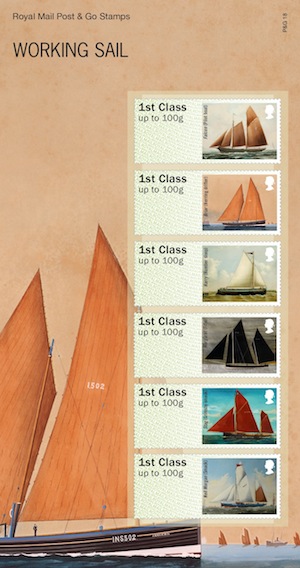
Briar (Herring Drifter) by
Alexander Harwood, 1907
Alexander Harwood (1873–1943) moved to Aberdeen in his twenties and worked
as a fish porter for most of his life. He was a prolific amateur artist and
painted hundreds of portraits of Aberdeen trawlers, working in watercolours,
oils and gouache.
Harry (Humber Sloop) by Reuben
Chappell, date unknown
Reuben Chappell (1870–1940) was born in Goole and from an early age showed a
talent for drawing ships. He made his living by painting ships and selling
his oils and watercolours to seamen, first in Goole and then in Cornwall,
where he became well known locally.
Margaret (Fifie) by Henry Lawson,
1890
Henry Lawson (1872–1966) was a fisherman in Pittenweem who, as a teenager,
earned extra money by painting boats. The Margaret was his father’s first
boat and was used for line-fishing as well as drift-netting.
Stag (Grimsby Smack) attributed
to George Race, date unknown
George Race (1872–1957) lived in Cleethorpes and specialised in painting
portraits of trawlers arriving at the dock and would then sell his work to
the seamen before their vessel left the port.
Nell Morgan (Smack) by G Ramsey,
1886
Not much is known about G Ramsey, except that he lived in Norfolk and
presumed to have been among the local ‘pierhead’ painters. He actively
painted sailing vessels between 1856 and 1889.
Technical details:
Designed by Osborne Ross the six 56mm x 25mm stamps are printed in gravure
by International Security Printers, with two phosphor bars. The stamps
in the pack will have the service indicator and other detail printed in
gravure. All images are by kind permission of Royal Mail, Copyright
2015. This website is copyright Norvic Philatelics 2015.
Picture sources: Falcon -
Lancashire County Council Museum Service; Briar
- Lossiemouth Fisheries and Community Museum; Humber
Sloop Harry - National Maritime Museum; Margaret
- Scottish Fisheries Museum Trust Ltd; Stag
- North East Lincolnshire Council; Nell
Morgan - Norfolk Museum Service.
Products issued
The labels will be used in Post & Go machines at Post Offices around
the country, and from the Royal Mail machines at Spring Stampex.
A mint set of 6 x 1st will also be available from Royal Mail's Tallents
House Bureau in a pack similar to a presentation pack. All values in
the pack are 1st Class.
Royal Mail will again produce a First Day Cover and official First Day
Postmarks for these stamps.
Special Postmarks
Postmarks available for the day of issue will be shown here These are
not to scale. These postmarks cannot be obtained after the date
of issue.
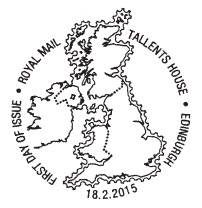
|
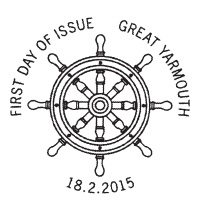
|
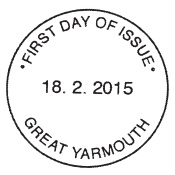
|
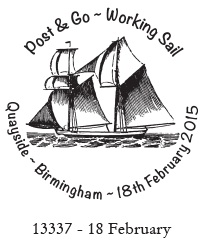
|
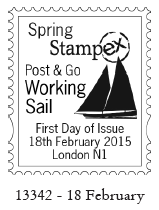
|
| Ref FD1504TH Philatelic Bureau Official Postmark illustrated
with a map of the British Isles |
Ref FD1504PL Great Yarmouth first day postmark showing ship's
wheel.
|
Ref FD1504NP Great Yarmouth non-pictorial first day postmark |
Ref M13337 Working Sail, Quayside, Birmingham
|
Ref L13342 Spring Stampex Post and Go Working Sail, London N1 |
 |
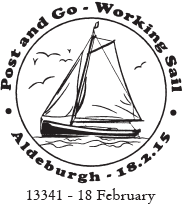
|
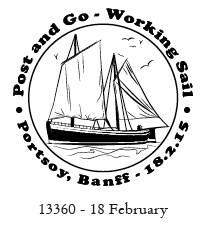
|
|
Ref L13330
River Thames, London SE1
|
Ref L13331
Working Sail, Greenwich SE10 |
Ref L13341 Aldeburgh, Suffolk
|
Ref W13360 Portsoy, Banff
(Yes, this Scotland postmark is being handled by Cardiff SHC)
|
|
This page updated 10 February 2015
If you wish to be told when this page is updated, please use the
ChangeDetection box at the top of this page.
If you have any questions, please email
us.
NB: all emails will be acknowledged in 1-2 days
unless we are away (see home page). If you do not receive an
acknowledgement please email us from a different address (eg hotmail,
gmail).
Instant
Printing Prices from Webmart

